Frugtfluer:Sommerskadedyr eller videnskabeligt vidunder?

Drosophila melanogaster. Kredit:Columbia's Zuckerman Institute
Fluesæsonen er her. Så snart du placerer dine friske jordbær på køkkenbordet, kommer den første frugtflue. Det vil ikke tage lang tid, før en gruppe Drosophila-kammerater svæver omkring byttet.
Hvis du vælger at slå, stryge, smække, baghånd eller på anden måde forfølge dine insekticide tilbøjeligheder, skal du ikke spilde et lærende øjeblik. Alt du skal gøre er at omfavne den tidløse maksime:Kend din fjende. Frugtfluen er en fast bestanddel af laboratoriet og har vist sig at være en uendelig kilde til biologisk inspiration og viden om, hvordan hjernen og kroppen udvikler sig og fungerer.
Lektion 1:Frugtfluer har eksisteret længere, end vi har – meget længere
Højst sandsynligt vil du fejle dybt i din iver efter at fjerne dine interne frugtfluer. Det er ikke, at du er ude af stand til at opstille dine dødelige slag. Det er bare, at evolutionen har finpudset fluernes små hjerner, vinger, sansesystemer, muskulatur og indre organer i kunsten at overleve i omkring 40 millioner år. Det er 38 millioner flere år, end det har taget for os Homo sapiens at udvikle sig fra vores Australopithecus-forfædre. Frugtfluer har været i evolution skole meget længere end menneskeheden.
Lektion to:Frugtfluer har en kultfølge i videnskaben
Tidligt i det 20. århundrede var en af de første forskere, der tog imod denne uvidende gave til videnskaben, Columbia Universitys Thomas Hunt Morgan. I 1910 bemærkede Morgan, at han nemt kunne få øje på mutationer, såsom store hvide øjne i stedet for fluernes sædvanlige store røde. Han og hans laboratoriekammerater lærte, hvordan man forbinder disse fysiske mutationer til specifikke genetiske strækninger placeret langs insekternes kromosomer.
Siden da er disse små leddyr forblevet elskede og afslørende forskningspartnere. For meget af det, vi ved om genetik, arv, biologisk udvikling, sensorisk videnskab, mange sygdomme og utallige andre facetter af biologien, har vi frugtfluer at takke. En nylig undersøgelse af frugtflueforskningssamfundet viste, at et estimat på mere end 6.000 "fluearbejdere verden over virker konservative."
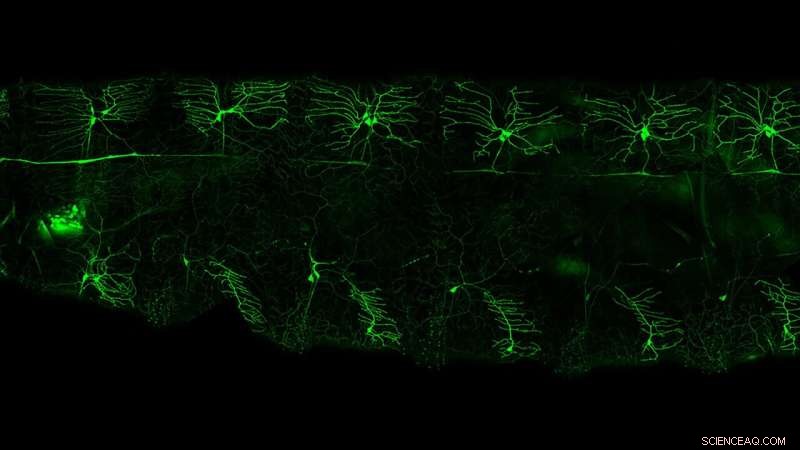
Fluorescerende mærker afslører sensoriske celler fra en fluelarve. Kredit:Grueber Lab; Zuckerman Institute
Lektion tre:Frugtfluer er små Houdinis
Når en frugtflue står over for en trussel, kan den reagere næsten øjeblikkeligt. To make basic evasive movements, the insect, even in its larval stages, has to keep precise track of where its body is in space. This body-place sense, common to all animals, is termed proprioception. It allows humans, for example, to know where their limbs are without looking directly at them and to make fine adjustments during any movement, such as reaching for a strawberry.
Wesley Grueber, Ph.D., and his colleagues at Columbia's Zuckerman Institute discovered that a collection of sensory cells in the fly allow it to keep precise track of where different body regions are located during movement.
Dr. Grueber points out that similar cells and circuits probably kick in when flies make those aeronautic escape sequences that have you cursing in the kitchen. That is, unless your deftly executed backhands squash the fleeing fruit flies, so that their previous and gorgeous marriage of form and function morphs into entropic functionless stains.
Lesson four:Fruit flies have 1,600 eyes, sort of
If you could pick through the aftermath of a swatted fruit fly's 580,000 or so cells, you would find at least some of the 800 light-harvesting facets, or ommatidia, that comprise each of a fly's eyes. You might also find remains of the 200,000 neurons that make up the fly's nervous system and thereby the circuitry it had used to see the world.
You would also be wandering into the territory of Rudy Behnia, Ph.D., a principal investigator at the Zuckerman Institute. Among other things, Dr. Behnia has been teasing out the cellular circuitry and computations that underlie fruit flies' color vision.
"Spectral information in the world is very rich and flies could use it for object recognition," as well as for determining the time of day and navigating with cues about the sun's location from the sky's color, Dr. Behnia says.
As is evident from your terrible batting average when it comes to fly-squishing, your insect nemeses know your murderous hand is coming. This intel derives from signal-delay circuitry built into the fruit fly's visual system. If the initial sensory signals change between ommatidia, as happens when your hand is sweeping through a fly's field of view, the resulting signal patterns deeper in the fly's brain carry information about the direction your hand is moving.
Now add in the fly's phototaxis, which plays into its knack for detecting and moving toward ultraviolet light, and you have the neurobiological foundation for an escape plan. "Since most objects in nature reflect rather than absorb ultraviolet radiation, the main source of natural UV is the open sky," Dr. Behnia explains. That means that if you are a fruit fly, and you detect ill will coming your way, you just need to follow that UV to the open sky.
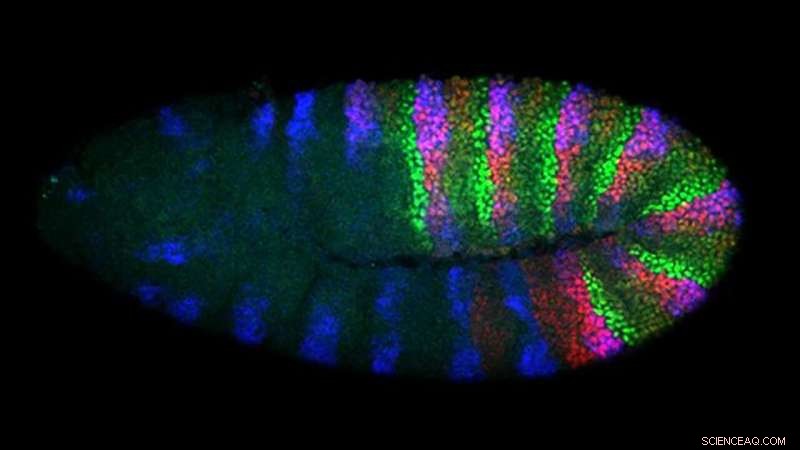
Fluorescent labels demarcate larval locations of specific Hox genes. Credit:Mann Lab; Zuckerman Institute
Lesson five:Fruit flies do mind-bending math, all in their heads
To plot their course through the world, and escape trajectories in times of peril, fruit flies use external reference points, such as the position of the sun, along with serious mental mathematics.
"The flies are doing trigonometry," says Larry Abbott, Ph.D., co-director of the Center for Theoretical Neuroscience at the Zuckerman Institute. "It's incredible."
A fly's mental computations start by representing vectors, mathematical arrows with angles and lengths that themselves represent the direction and speed of motion. Dr. Abbott and his colleagues discovered that the flies use wave-like patterns of brain activity to encode these vectors. The amplitudes and phases of those neural wave patterns match the lengths and angles of the corresponding vectors in actual space.
"Flies perform the types of vector calculations often assigned in introductory physics classes, but they do this in ways that are not typically taught in such courses," says Dr. Abbott, adding that he is looking forward to the arrival, later this summer, to a new colleague at the Zuckerman Institute, Dr. Gwyneth Card. She will investigate the neural circuitry flies use to decide exactly what escape response to enact, say, as a threatening human hand violates their personal space.
Lesson six:The same genes that grow humans grow flies
A fly contains half a million cells, distributed among more than 200 cell types and organized into body parts ranging from the antennae on the front of its head to the hairs on its posterior. This sophisticated body plan emerges from a fertilized egg thanks to a mere eight genes in the Hox family:the master conductors of development.
Over many years of investigations, Richard Mann, Ph.D., another Zuckerman neuroscientist who studies fruit flies, has been teasing out how Hox genes, transcription factors, and many other genes and proteins coordinate their fly-building feats according to a brilliant logic of biological development. What scientists learn about this logic in model organisms like fruit flies often points to analogous developmental logic in people, says Dr. Mann. He stresses that the genetic common ground for humans and fruit flies extends beyond development genes. Says Mann:"So many human genes are also found in flies and a majority of human disease genes are also found in flies."
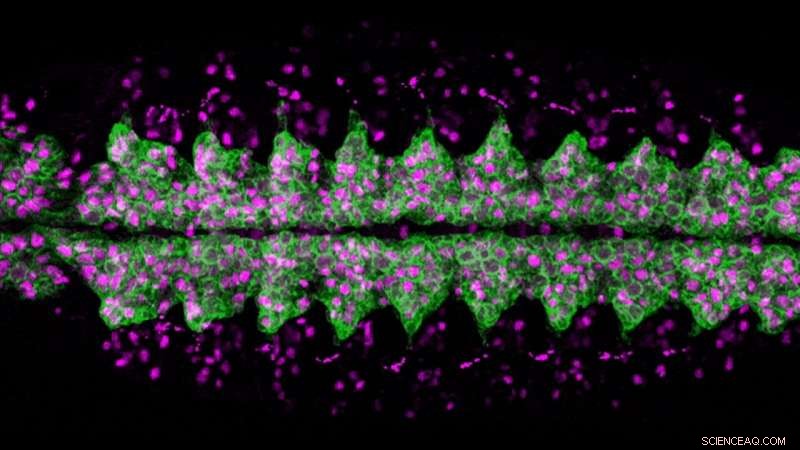
A green stain reveals neuroblasts, which are precursor cells that become neurons, specifically in the nerve cord of a fly embryo; the magenta stain lights up neuroblasts residing both within and without of the nerve cord. Credit:Kohwi Lab; Zuckerman Institute
Lesson seven:Fruit flies are symphonies of genetic and cellular notes
Extracting yet more biological insight from fruit fly genes is Zuckerman Institute principal investigator Minoree Kohwi, Ph.D.. She has been identifying the specific places and times in which development genes become active in sequential generations of cells of a growing fruit fly.
"Think of each gene as a single musical note:by itself, a note is an isolated sound, but play each note at the right time for just the right duration, and you get a beautiful symphony," Dr. Kohwi said.
One of the big questions she aims to answer is this:"How are the thousands of different cell types produced in such an organized manner to allow proper brain function?"
Dr. Kohwi's lab is uncovering the origins of a fly brain's many different cell types and thereby helping to reveal the origins of a similar diversity of cells in her own brain. Her research excavates deep into the molecular foundations of life by revealing how and when development genes migrate to different locations within a cell's nucleus. These migrations regulate when specific development genes are active and when they are repressed. And those on-off sequences, Dr. Kohwi says, "ultimately determine when each brain cell type can be made during development."
Squashing a miracle
Few Drosophila researchers would think twice about defending the fresh fruit on their tables with lethal force. But because of what they know about the marvels of fruit flies, you might see a flash of fly-admiration on their faces in the moment you hear thwap.
 Varme artikler
Varme artikler
-
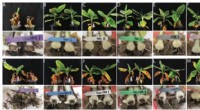 En mulig måde at give TR4-svampresistens over for Cavendish-bananer(A-G):Eksterne og indre symptomer seks uger efter enkeltpodninger med (A) Fusarium odoratissimum TR4, (B) F. oxysporum f. sp. melongenae, (C) F. oxysporum f. sp. cepae, (D) F. oxysporum f. sp. lycoper
En mulig måde at give TR4-svampresistens over for Cavendish-bananer(A-G):Eksterne og indre symptomer seks uger efter enkeltpodninger med (A) Fusarium odoratissimum TR4, (B) F. oxysporum f. sp. melongenae, (C) F. oxysporum f. sp. cepae, (D) F. oxysporum f. sp. lycoper -
 Kartoffelforædlingsprogram retter sig mod pommes frites, chipping, friske markederEn lilla-kød kartoffel er en af de unikke kloner, Texas A&M AgriLife kartoffel avlsprogram dyrker i markforsøg nær Springlake. Kredit:Texas A&M AgriLife foto af Kay Ledbetter Nye kartoffelsorter
Kartoffelforædlingsprogram retter sig mod pommes frites, chipping, friske markederEn lilla-kød kartoffel er en af de unikke kloner, Texas A&M AgriLife kartoffel avlsprogram dyrker i markforsøg nær Springlake. Kredit:Texas A&M AgriLife foto af Kay Ledbetter Nye kartoffelsorter -
 Sådan bygger du en albue-fælles modelDen menneskelige krop indeholder et par forskellige typer led. En af dem, hængselsleddet, findes i albuen og knæet. Et hængselsfug gør det muligt for en kropsdel at bevæge sig i kun to retninger, ud
Sådan bygger du en albue-fælles modelDen menneskelige krop indeholder et par forskellige typer led. En af dem, hængselsleddet, findes i albuen og knæet. Et hængselsfug gør det muligt for en kropsdel at bevæge sig i kun to retninger, ud -
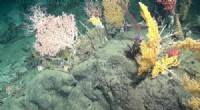 Antibiotika opdagelse i afgrundenDet dybe hav er et af de mest ekstreme miljøer på Jorden, og mikroorganismer, der lever der, kan holde nøglen til at bekæmpe AMR. Kredit:University of Bristol Ved at kombinere innovationerne inden
Antibiotika opdagelse i afgrundenDet dybe hav er et af de mest ekstreme miljøer på Jorden, og mikroorganismer, der lever der, kan holde nøglen til at bekæmpe AMR. Kredit:University of Bristol Ved at kombinere innovationerne inden
- Asymmetrisk jodesterificering af simple alkener ved koncertkatalysator
- Afsløringen af skorpegeometrien i de vestlige Qilian-bjerge, NØ Tibetansk Plateau
- Forskere beskytter hardware mod cyberangreb
- At reducere drivhusgasemissionerne ville hjælpe byer verden over med at stige til havs
- Hvad er karakteristika for Protista Kingdom?
- Post-Sovjetunionens lykkelag mellem Øst- og Vesteuropa forklaret


